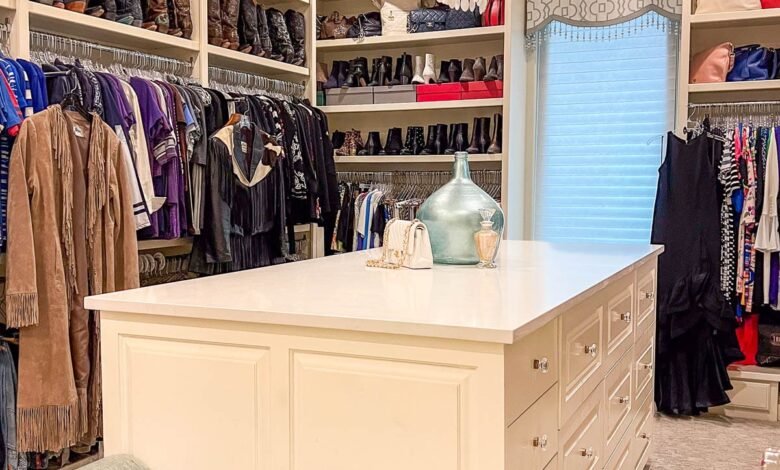One Closet, Big Style: How to Stay Stylish with Only One Small Dorm Closet

Introduction
Living in a dorm with a single small closet doesn’t mean sacrificing style. In fact, constraints can be your creative advantage: fewer choices force smarter purchases, better care, and smarter outfit planning. This article is written with principles in mind clear, practical advice grounded in widely accepted wardrobe-management and organization strategies so readers can trust the tips and apply them easily. Whether you’re a first-year student packing for move-in week or returning to campus and trying to downsize, these strategies will help you build a compact, stylish wardrobe that’s easy to maintain, quick to assemble, and appropriate for classes, events, and casual weekends. The focus here is on functional decisions what to buy, how to store it, and how to plan outfits so that a single small closet becomes the launching pad for a confident, polished campus look.
Maximize vertical space
Small closets usually have more height than they appear to use. Think vertical: install a slim shelving unit or stackable cubes to hold sweaters, shoes, and folded tees, and add adhesive hooks or over-the-door hangers for bags, scarves, and hats. Use tiered hangers to hang multiple garments in one slot and invest in slim, non-slip hangers to save width. Clear, labeled storage boxes let you see seasonal items while keeping them dust-free; place less-used pieces on the top shelf. Don’t forget the closet floor shoe organizers, narrow bins, or a shallow rolling drawer can store sneakers or laundry supplies without blocking access. For doors with limited hardware, command hooks and removable rails are dorm-friendly and won’t damage walls. The goal is to turn unused vertical real estate into organized pockets for specific item types so the one small closet feels roomy and everything has an obvious place making outfit building faster and preventing clutter from overflowing into your room.
Build a capsule wardrobe
When closet space is limited, a capsule wardrobe is your best friend. Start with a neutral base classic jeans, a tailored jacket, a versatile dress, a few tees, and a pair of simple sneakers then add 4–6 accent pieces that can be combined in different ways. Choose fabrics that drape well and resist wrinkles (jersey, modal, cotton blends) and colors that coordinate so you can create multiple looks from fewer items. Aim for one quality outer layer, two pairs of shoes (casual and dressy), three bottoms, and about six tops that swap easily between casual and semi-formal settings. Accessories like belts, scarves, and a single statement bag can transform outfits without occupying much space. Prioritize multi-use garments a blazer that works for presentations and nights out, or a dress that layers under sweaters so every piece earns its spot. Being intentional with purchases reduces decision fatigue and keeps the closet functional while allowing a wide range of styles with minimal pieces.
Smart storage solutions
Storage tools turn chaos into calm. Use clear stackable bins for underused items and rotate seasonally: keep out current-season clothes and store heavy coats or summer swimwear in labeled boxes. Drawer dividers or small fabric organizers are ideal for socks, underwear, and jewelry these take little room but drastically improve accessibility. Vacuum-seal bags are useful for bulky winter wear when space is at a premium, but remember they compress fabrics (don’t store delicate knits this way long-term). Shoe organizers that hang on the closet rod free floor space while keeping pairs visible. For delicate or special garments, a slim hanging garment bag protects them and keeps the rest of the closet tidy. Keep a laundry basket or a hanging laundry bag nearby to prevent dirty clothes from mixing with clean ones. Finally, document your rotation system simple labels or a checklist on your phone helps you remember what’s in storage so you won’t repurchase duplicates when seasons change.
Daily routines & clothing care to keep looks fresh
Small closets demand care routines that extend garment life and keep outfits ready. Adopt a nightly outfit prep: choose tomorrow’s clothes, check for stains, and set up shoes and accessories so mornings are stress-free. Spot-treat stains immediately and air garments after wearing to reduce washing frequency, which preserves fabric and saves space by preventing pile-up. Learn basic mending sewing on a button or fixing a small seam saves a garment’s place in the rotation. Use travel-size fabric spray or a handheld steamer to remove wrinkles quickly without needing lots of ironing space. Fold heavy sweaters rather than hanging them to prevent stretching; hang shirts and dresses to keep silhouettes crisp. Keep a small sewing kit, lint roller, and stain remover tucked in the closet for easy access. These small daily habits prevent clutter, prolong clothing life, and ensure that the limited space you do have houses only items you actually wear making it easier to present polished looks every day.
Conclusion
A single small dorm closet can be more than adequate it can be an efficient, stylish hub that supports a variety of looks without excess. The combined approach of maximizing vertical space, building a thoughtful capsule wardrobe, using smart storage tools, and maintaining daily care routines will transform an overcrowded, chaotic closet into a simple system that saves time, money, and stress. By buying intentionally, organizing deliberately, and caring consistently for garments, you’ll maintain a curated wardrobe that reflects your style without demanding a lot of space. The result? You’ll step out to class or campus events looking composed and confident, proving that style is as much about choices and care as it is about quantity.
FAQs
Q: How many pieces should I aim for in a dorm capsule wardrobe?
Aim for about 25–35 pieces total (including shoes and outerwear), focusing on interchangeability so each item can create multiple outfits.
Q: What’s the best way to store shoes in a tiny closet?
Use slim vertical shoe racks, hanging shoe organizers, or clear stackable boxes to keep pairs visible and off the floor.
Q: Can I keep bulky coats in a dorm closet?
If space is tight, rotate bulky coats seasonally into labeled bins or vacuum-seal bags and store them under beds or in an attic/storage unit if available.
Q: Any quick tips for keeping clothes fresh without many appliances?
Air clothes after wearing, spot-treat stains, use a handheld steamer or wrinkle-release spray, and prep outfits the night before to avoid last-minute messes.



